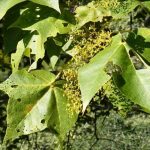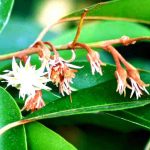TREE LIFE
April 1986
MASHONALAND CALENDAR
Tuesday April 1st : Botanic Garden Walk.
11 – 14th April : Mana Pools trip
Sunday April 20th : Mpondaminga on Kilmacduagh Estate, Home of Mr. Lance Perry. I well remember Mr. Perry’s farm as the first Tree Society outing I ever attended. Since then I have been longing to get back to this rewarding stretch of the Great Dyke. Mpondaminga overlooks the gorge cut through the dyke by the Maquadzi River and therefore has superb view and excellent woodland with unusual species. At this point the Maquadzi is also free from crocodiles as well as from bilharzia as the snails cannot tolerate the high metal toxicity of the waters. After a morning along the river, lunch on the lawns, including a rapid swim for those so inclined, and a walk into the nearby hillside. We will stop on our return journey to explore a small patch of swamp forest used for the filming of King Solomon’s Mines. We have organized a bus departing from Monomatapa Car Park at 0830 sharp. A security guard will look after the cars.
MATABELELAND CALENDAR
Sunday April 6th : We will go to Northway Extension. Meet at 0830 hours in Northway at the junction with Burnside Road.
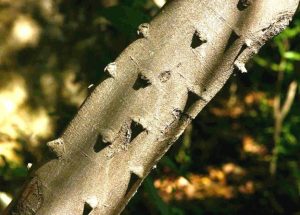
Zanthoxylon capense. Photo: Bart Wursten. Source: Flora of Zimbabwe
On Sunday March 2nd we went to Mabukuweni and had a most pleasant outing. We identified some 50 trees, only about half of what we know to be present, but, then we only investigated one side of the area. These included : Acacia gerrardii, A.karroo, A.nilotica, A.rehmanniana, A.sieberana, Albizia amara, Albizia antunesiana, Aloe excels, Azanza garckeana, Bridelia mollis, Burkea africana, Commiphora mollis, stems not very square!; Commiphora schimperi, with leaves very small, Croton gratissimus, Cussonia natalensis, Erythrina latissima, Euclea natalensis, Faurea saligna, this with unusually narrow leaves; indeed, much that we saw seemed smaller or narrower than the normal, if one may use such a term, either affected by drought, or by the very rocky surrounds, or both; Ficus glumosa, Ficus thonningii, Grewia flavescens, Grewia monticola, Lannea discolor, Maytenus senegalensis Olea europea subsp. africana, Osyris lanceolata, Pavetta gardeniifolia, Pavetta schumanniana, Pouzolzia mixta, Pterocarpus angolensis, Pterolobium stellatum, Rhoicissus tridentata, Schrebera alata, Sclerocarya birrea, Securidaca longepedunculata, Sericanthe andongensis, Terminalia sericea, Turraea nilotica, Zanthoxylon capense, Fagara, Ximenia caffra, Ziziphus mucronata.
–C.Sykes
BOTANIC GARDEN WALK, MARCH 1986 : THE ECONOMIC SECTION
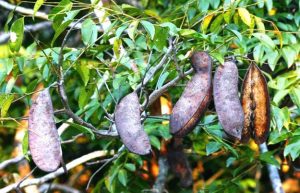
Erythrophloem sivaveolens. Photo: Bart Wursten. Source: Flora of Zimbabwe
It was a pleasure to investigate the Economic Section of the Botanic Garden as this has remained a mystery to most of us. Bob Drummond kindly researched the section for us and led an enjoyable walk
Apparently, Tom originally planned a poison section and we saw the large specimens of Melia azedarach, Erythrophleum suaveolens and Albizia versicolor. This idea was then modified to include plants which are potentially of economic importance in Zimbabwe and these will be discussed in the order in which they are growing. Dick Petheram kindly wrote the notes on Leucaena and Pochota and Barbara Browning helped with the grasses and in directing the walk.
Phyllostachus viridis, POACEAE, BAMBUSOIDEAE. The fast-growing young stems of this species are apparently free from acridity and may be cooked as bamboo shoots in Chinese cooking.
Actinidia chinensis, Theales : ACTINIDIACEAE. The Chinese gooseberry or Kiwi fruit as it is termed locally is a woody vine that produces these familiar fruit.
Strophanthus kombe APOCYNACEAE. The seeds of this indigenous creeper are deadly poisonous due to the cardiotoxic glycoside called strophanthin. When extracted and used correctly it can treat heart ailments. The same chemical can also be used to manufacture cortisone, a hormone that is usually secreted from the cortex of the adrenal gland and helps to relieve swelling. This plant is common in the valleys of the Zambezi and Sabi Rivers and has spectacular flowers.
Phoenix dactylifera ARECACEAE. These date palms were grown from seed collected from Nigeria and were thought to be more suited to higher rainfall area. Cheryl has successfully germinated seeds from packets of dried dates, although most palms needs to be planted very fresh as according to Prof Corner there is no dormant phase, the embryo simply grows very slowly.
Cyphomandra betacea SOLANACEAE. The tree tomato which fruits profusely in and around Harare.
Syzygium cuminii MYRTACEAE. The jambolan with larger fruits than our local wterberry.
Rubus niveus ROSACEAE. The dusty berry. This is a large genus that includes the raspberry, blackberry and loganberry. Dustyberries self seed all around our garden and besides keeping the kids happy for hours they make a fine wine.
Spondias cytherea ANACARDACEAE These otaheits apples were just coming into fruit so we did not taste them. Brian found an interesting reference to the related S.mangifera which stated it had a “flavour like that of an exceedingly bad mango”. Apparently, it makes an excellent preserve.
Coffee arabica RUBIACEAE and Camellia sinensis THEACEAE provide coffee and tea respectively. The untrimmed tea plant showed its natural tree like habit, the trimming to bush form is only for better picking. The flowers showed its resemblance to the Camelia we grow in gardens.
Cananga odorata ANNONACEAE is cultivated for the scent of its flowers. The distilled scent is called ylang-ylang or cananga and apparently 1 acre of trees may produce 3000lb of flowers or 15lbs of extracted essence.
Elaeis guineensis ARECACEAE. The West African oil palm that is being cultivated for a plantation in the S.E. Lowveld. These nuts yield two types of oil, that from the outer covering is used in cooking and lighting, that from the kernel is used for margarine and cooking fats.
Bixa orellana BIXACEAE. This lipstick tree is a suitable garden subject with dark leaves and a crown of pink floers. The seeds are covered with a crimson coat that yields annatto, a food colouring.
Olea europaea OLINIACEAE. The olive tree
Swietenia mahagoni MELIACEAE. The mahogany
Averrhoa carambola OXALIDACEAE. It is very unusual to find a tree like this in the same family as sorrel, this species produces carambola, an edible fruit
Malpighia glabra MALPIGIACEAE. The Barbados cherry is grown for the high vitamin C content of its fruit. We found a few ripe fruit and grimaced with the ascorbic acid level, do people enjoy them?
Murraya koenigii RUTACEAE. The compound leaves and gland dots reveal this plant’s family. A number of folk were impressed with its aromatic smell, it is generally added to curry and may be purchased in town. Some of us found the association too close to that of Clausena anisata, perdepis, to actually enjoy. Although every now and then even a Clausena can smell like aniseed.
Jatropha curcas EUPHORBIACEAE. The black physic nut is used as a local medicine to cure many ills and has been widely distributed in Zimbabwe. It grows around Diana’s Vow as a small shrub.
Aleurites fordii EUPHORBIACEAE. The fruit of this Chinese tree yields an oil which dries and so is used in paint, varnish and linoleum. It has been extensively cultivated in Malawi.
Hevea brasiliensis EUPHORBIACEAE is the source of para rubber.
Manihot esculenta EUPHORBIACEAE is the cassava. These tubers all contain cyanide and generally need tobe cooked or dried in order to render them edible. When the University’s bush was cleared out for building operations the workers rushed in and started eating them raw, despite my dire warnings. They lived to prove me wrong and proclaim something about yellow petioles vs red petioles – I gave up.
Simmondsia chinensis EUPHORBIALES, SIMMONDSIACEAE. In spite of its Latin name the Jojoba comes from the western USA. This bush has been hailed as a possible part solution to the petrol crisis.
Coix lachryma – jobi POACEAE. This grass has seeds called the tears of Job and these are often used as rosary beads. A thin-shelled variety is prepared and eaten like barley.
Cymbopogon citratus POACEAE. The lemon grass smells like lemon creams. These oils are extracted and used to scent soaps or to manufacture the scent of violets as well as vitamin A, all these compounds are chemically related. The essential oil in lemongrass can now be made artificially and so it is no longer extracted from the plant.
Pochota glabra BOMBACACEAE. The pichina nut, which we passed on our way to the jackfruit, obviously got its common name from Pachina glabra, which was for a time the botanical name of the bush or tree. Prior to that, it was called Bombacopsis glabra, and before that, Bombax oleagineum – pointers to the fact that it is of the Bombacaceae family, as are the baobab and the kapok trees. Its botanical name is now Pochota glabra.
Other common names are wild cocoa, see below, water chestnut and Guyana chestnut. The last of these seems not inappropriate; it hails from S.America and the 10cm long, rugger ball shaped, hard shelled fruit splits open to reveal irregularly rounded seeds, each with its own thin brown protective skin. These can be eaten raw or lightly roasted. A trifle floury they seem to us, but pleasant.
The cocoa tree by the way, by name Theobroma cacao I believe at the time of going to Press, belongs to the related family STERCULIACEAE. Judging from the literature, its fruit might be similarly shaped, but are appreciably longer.
Artocarpus heterophyllus MORACEAE. The jackfruit in the garden have grown large and one tree is even fruiting. These large fruit, up to 70lbs.have a pungent odour which Brian found described as “mawkishly sweet and mousy”.
Artocarpus altilis MORACEAE. This tree, responsible for the Mutiny on the Bounty, has a palmately lobed leaf and the fruit has an overpowering odour which is “not considered a drawback” by the locals. Tom’s tree dies back each winter but is growing out once again.
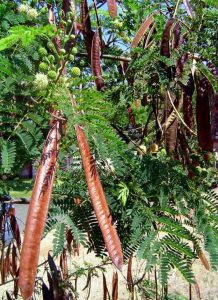
Leucaena leucocephala. Photo: Bart Wursten. Source: Flora of Zimbabwe
Leucaena leucocephala MIMOSACEAE. Among the first of the plants we saw in the legume Leucaena leucocephala. There are various strains of this species, as well as several species of the genus – which might make the whole subject of leucaena seem too complicated to bother about. However, it is worth more than a passing thought, since it is being experimented with in numerous tropical and sub-tropical countries, including Zimbabwe, for its highly beneficial nitrogenous contribution to soils, its value as excellent forage for ruminants and in some forms and in some environments, its speedy growth into trees of a size suitable for firewood. It can be used also as shade trees for plantation crops and as a source of dyes.
The very young seeds and leaves of this Central American plant are eaten by people in some rural areas of Central America and S.E. Asia, but the foliage contains an amino acid called mimosine and this can cause weight loss and ill health in non-ruminants. Any tendency to indulge in such snacks to excess in the Botanic Garden should therefore be discouraged. Ruminants have microorganisms that render mimosine harmless, so take your pet cow or goat along on a lead, if the urge is irresistible.
We must thank Bob for an interesting walk, there are still a few trees I missed out on, such as the kapok, the carob and the raisin tree, next time I will be more attentive.
GLETWYN, HOME OF IAN AND BIDDIE ROSS : SUNDAY 16TH MARCH
Details of the AGM held on the lush lawns of Ian Ross’ homestead, on Gletwyn, will follow in the Minutes. However, members should be advised of the officers elected as follows:
Chairman Kim Damstra Secretary Sheila Weaver
Vice Chairman Marjorie Barker Treasurer Joy Killian
Committee members : Meg Coates Palgrave, Georgie Granelli Pat Walker Margaret Bennett Molly Kilpeert Vida Siebert Maureen Lumhoist-Smith Philip Haxen
With little time left before lunch after our AGM members nonetheless ventured out like mad dogs and Englishmen in the midday sun to see what of interest was to be seen on the low kopje behind the picnic site.
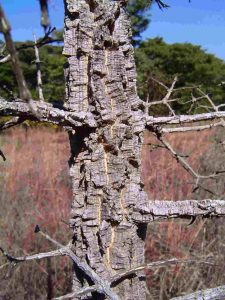
Strychnos cocculoides. Photo: Bart Wursten. Source: Flora of Zimbabwe
I first saw a fine Strychnos cocculoides, although bereft of fruit it was diagnosed by the characteristic curving branches and the three leaf veins emanating from the base. The fire-resistant corky bark determined the species.
Higher up the hill was an Erythrina abyssinica which we separated from E. latissima by its smallish leaves. A number of Faurea speciosa were present and though not in flower, the marginal vein and somewhat broad leaves were sufficient to identify this.
A good deal of time was spent discussing textures of trees and how this applied to Lannea discolor and Pterocarpus angolensis. The idea is that one is not looking to see how man leaflets the tree has, whether they are paripinnate or imparipinnate or indeed whether they are leaflets or leaves, but rather one throws it all in together and tries to get the “feel” of a tree. One can develop this ability to a fine art until, like Tom Muller, one identifies trees at 120km/hr.
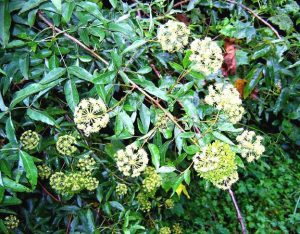
Heteromorpha trifoliate. Photo: Bart Wursten. Source: Flora of Zimbabwe
Kim told me that his party saw a number of sizeable Ochna schweinfurthiana and Turraea nilotica. They also saw Heteromorpha trifoliate which performed very well by producing a distinct carrot smell from the crushed leaves, underlining their common lineage in the UMBELLIFERAE.
Another spectacle which caught my attention, despite baby/little girl’s determination to undermine my otherwise riveted concentration, was Uapaca kirkiana, mushanja or muhobohobo. The sexes are on separate trees and this was most obvious as all the males were covered in dead flowers and in this area males appeared to be in a strong majority – viva Uapaca!
Next on the list was lunch, followed by the contrasting excitement of the afternoon jungle.
-J.P.Haxen
The afternoon walk on Gletwyn was most interesting. We set out through typical Harare woodland with a tall grass understorey, past Uapaca and Brachystegia. The Albizia amara were interesting as Anton Ellert observed that the young shoots are coated in yellow hairs, this separates it from Albizia harveyi where the young shoots emerge a darker brown. We often have problems with these two species in the middle altitudes where they grow side by side. And then we dropped down into a gulley with permanent water and here the vegetation changed, the tall white trunks of Celtis africana held their chlorotic leaves high above us and Syzygium quineense grow to stout trees. The remarkable feature of these trees was the presence of numerous bright red pneumatophores, or “breathing roots”. These grow from the low trunk and also grow vertically out of the mud in the river and along the river bank. Each root has a slightly swollen tip and the cells inside similar roots in other plants generally have large intercellular spaces through which the respiratory gasses move. Roots, like all living things, need to breathe oxygen and excrete carbon dioxide. When flooded the roots are starved of oxygen, CO2 dissolves in water easily and is usually less of a problem. These breathing roots overcome the stress. None of us had ever seen roots like these on Syzygium before, but we will look out for them in the future.
The second find was a group of indigenous tree ferns, Cyathea dregei. Ian Ross assures us they were there when he was a child, and there is no record of them having been planted. Apparently, they do grow in local patches around Bulawayo, so this distribution is strange but not unique. When we did the recce I was surprised by the small prickles on the rachis of each frond and immediately thought of C.manniana although these ferns are very much narrower. Checking on the specimens in the Botanic Garden confirmed that C.dregei is also spiny but less so than C.manniana. These ferns suffered badly in the past few drought years and all the large specimens died, leaving five foot stumps with their hollow centres. Fortunately there are a number of youngsters that all look healthy. The forest was overgrown with Jacaranda, Cedrela and Lantana but nevertheless a rewarding place to visit. I am still amazed to think it is practically in the centre of town. We are really grateful to Ian and Biddie for their generous hospitality and for allowing us to share their farm.
-Kim ST.J. Damstra
-KIM DAMSTRA Chairman


